It suddenly dawned on me this morning that I have yet to write anything about my vermicomposting trenches this season! This is my favorite vermicomposting / gardening system after all, so I think it is time to bring everyone up to speed on this front.
I should mention right off the bat that most of my “trenches” are much more like windrows, due to an accumulation of rich vermicompost over time. Remember, I am not harvesting vermicompost from these beds – I am allowing plants to grow nearby and access the compost directly. What I AM harvesting from the beds, however, are Red Worms for my own small, local worm business – and in an effort to keep the ‘worm herd’ thriving I have been adding a fair amount of manure (primarily alpaca and horse manure), which certainly contributes to the mounding of the beds as well.
This year has been an amazing growing season in comparison to last year (for both worms AND plants). We’ve had lots of sun, lots of heat, but also lots of rain – so everything has been doing very well. I’ve included a shot taken back in June, showing the same garden zone shown in the first two photos above (taken this morning). As you can see, the plants have grown considerably in the last month!
8)
Some of you may recall that for the last couple of seasons, I have been growing tomatoes in the stretch of garden pictured above. Last year was NOT a great year for growing tomatoes, and I ended up with a pretty bad infestation of some sort of fungal leave disease (written about here: “Vermicomposting Trenches – 2009 – Update“), so I wanted to play it a little bit safe by basically keeping tomatoes out of that bed (pretty well the ONLY bed I don’t have tomatoes growing in this year – haha!). I also thought it would be fun to grow some corn along to fence so as to add some depth to my all-natural privacy fence!
Speaking of which…as you can tell, the sunflowers (of the “Kong” variety) are doing great on the other side of my fence. They are not really associated with my trench beds at all, but I have little doubt that they are still benefiting from the overall fertility of my yard these days. I will write more about them in another post.
Other plants growing in the beds adjacent to my trench windrows include zucchini (yellow and green), pumpkin, several varieties of pole beans, raspberries, and of course tomatoes! My sandbox raised bed garden is actually almost entirely dedicated to tomato plants this year, but I do have a few asparagus plants in there now as well. This is the one bed where the trench still actually looks like a trench. I have a huge beefsteak tomato plant (on the left in photo below – of course, the pic just doesn’t do it justice) which seems to really benefiting from the trench, and contributing to the reduction in volume that this stretch of trench seems to be experiencing (even though I’ve been adding a LOT of materials – alpaca manure, homemade manure, food waste etc).
Given the fact that I had so many tomato plants in need of a home earlier in the season, I needed to get a bit more creative with my plantings, above and beyond simply putting lots of them in my regular trench garden beds. I thought it would be interesting to see what happened if I literally planted some of them right in the trench itself, and on the lawn side. If you look back at the first three pictures you should see what I mean.
Of course, I couldn’t go TOO crazy with this approach, since I still needed to access the beds to get worms, add new material etc, so I ended up spacing them about 10 feet or so apart. As mentioned, a lot of manure has been added to these beds (and I have little doubt that the tomatoes have been benefiting from that), but I have also been adding a fair amount of food waste and grass clippings directly in behind each trench tomato plant. Not too surprisingly, these plants seem to be doing quite a bit better than the other ones (of the same variety) being grown next to the trench, but in the actual garden.
I’ve been pretty lazy with my approach to adding food waste during the last couple of months. Rather than bothering to make up a nice batch of homemade manure, I’ve simply tossed my bags of food waste (and shredded cardboard) into my deep freezer for awhile, and the frozen waste ball has then buried behind the plants.
Once the waste materials thaw out, they seem to all but vanish in a very short period of time! I suspect there are quite a lot more critters apart from worms benefiting from the addition of this stuff!
Anyway, I will definitely write more about my trench beds a bit later in the season (to let everyone know how everything turned out) – hopefully this has been enough to provide everyone with a decent idea of what I’m up to thus far!
8)

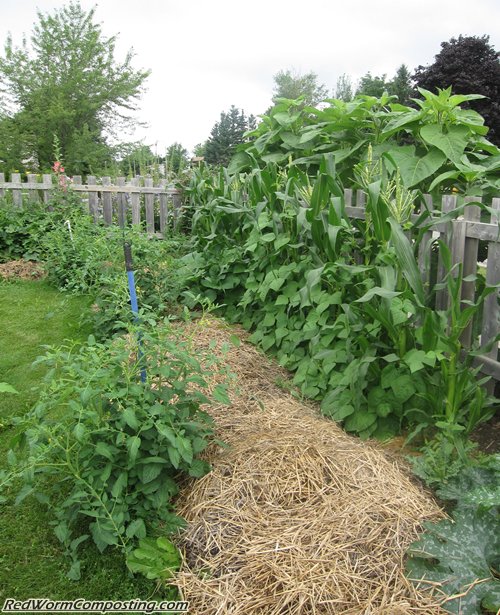
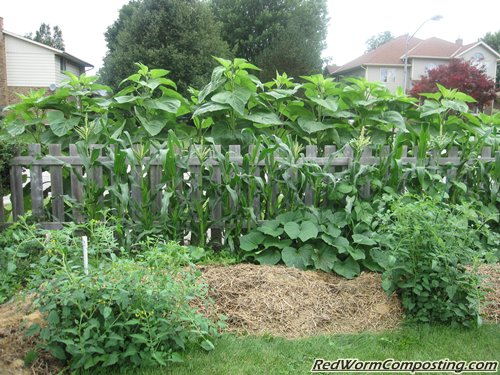
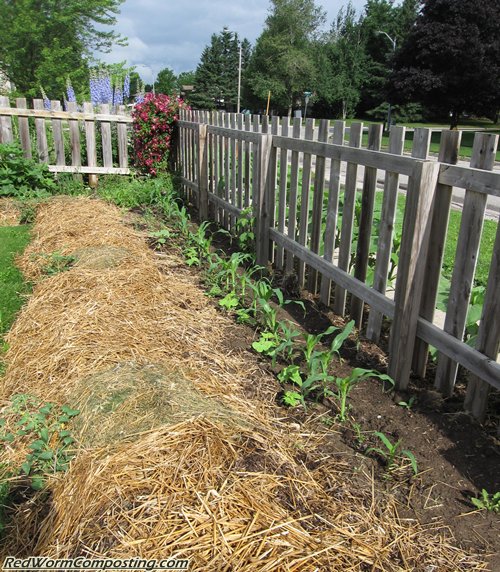
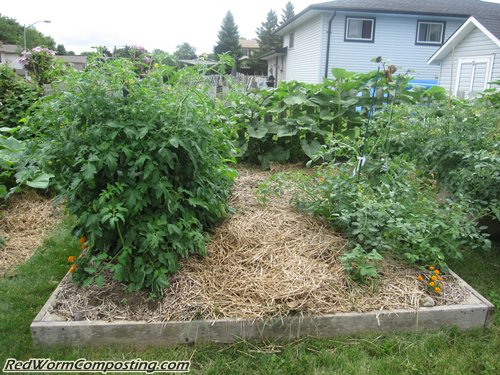
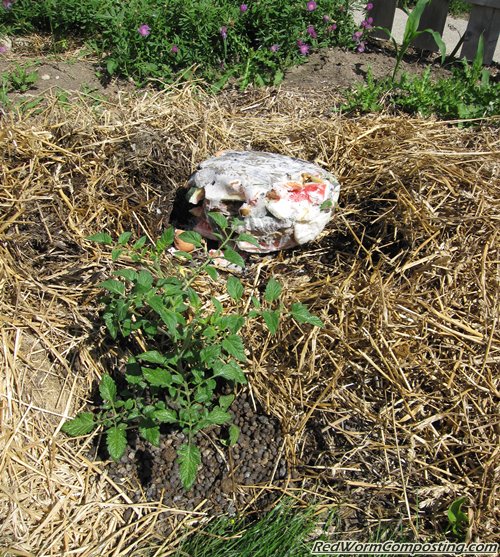

I’m curious about your neighbor’s gardens. Are they as lush as yours? Good soil helps, but also would bet that your worms don’t recognize property lines and may be working the neighbor’s soil, too.
Bentley–I have serious tomato envy! Mine are scrawny this year and seeing yours has made them seem even scrawnier by comparison.
I’m glad to see your addition of the compost close to the trench tomatoes is working. I had been wanting to add pre-composted material close to my tomatoes in my lasagna garden but have been afraid it would tie up the nitrogen and adversely impact the ‘maters. Now, I know I can do it with reckless abandon.
Bentley, what are the temperatures like where you are this time of year? I’m in Houston Texas and all my poor plants are getting burned! It’s already highs in the mid 90’s here!
My tomatoes,i threw in the towel.This is about as bumbed as i’ve ever been.Something vc can’t save you from.Only poison,which i am not ever using again.There are more than one species of stink bugs, that will even drain small green tomatoes all over.
So now i realized that i have to build raised beds.And i just ordered coco coir.But it’s too hot to build much of any thing! They have to have screen for this to work.So i can’t worry about it til fall! At least i’m growing organic.
I live by a major port and even see loads of lizard species that didn’t live here when i was a kid.I’ll try to identify the species of bugs.But i’m sure they are from Asia.
One neat larvae i did identify because it was by my worms was a lady beetle larvae.Maybe it is a sign of better days ahead.
Bentley you have the best looking worms and tomatoes i’ve seen.But at least i got some of your worms.Time to order more!
BARB – Only two neighbors with adjacent lots. The one directly behind us is much more interested in keeping a nice neat spread of grass than any real gardens – what’s kinda funny (in a semi-evil way – haha) is that my raspberry-plant-on-steroids at the back corner of my yard has sent a bunch of shoots up in a small ornamental garden directly across the fence from it. What’s interesting is that she has not hacked them back at all (as I would have expected). Perhaps my eco-gardening ways are…uhhhh…growing on her! Haha 😉
Either that or she saw the massive collection of juicy raspberries that were growing on our side of the fence!
As for the other neighbor (who actually shares a considerable stretch of fence-line), I like to think my practices have influenced the fertility of their beds running directly beside the fence, but all my trenches are basically on the other side of the yard so it’s not as much of an influence as it would be if they were on that side.
I wouldn’t be surprised if my Red Worms have made their way onto other properties in the area, but unless they are actives composters (a rarity around here) or they add lots of manure etc to their soil, I don’t think they will thrive.
——————————-
ANNA – I think it has definitely helped a LOT that I’ve been depositing so much rich material over the last few years. Even if some of the N gets bound up, I suspect there is plenty more that will remain available to the plants. I just hope all the other nutrients are readily available as well!
Haha – I must type slow! Two more people chimed in while I was writing!
😆
———-
CHRIS – We had a CRAZY heat wave not to long ago (for the better part of two weeks), with “feels like” temps (i.e. with humidex) up in your range. But that’s not our normal summer weather. Our normal “hot” summer weather is 80-86 range (~27-30 C or so) – in other words, most of our summer is ideal for gardening. My understanding was that a lot of people in your neck of the woods don’t even bother with summer gardening – I bet you must have a nice spring and fall growing season though, right?
————
LARRY – Sorry to hear about your tomatoes. I guess you are kinda in the same boat as Chris as far as heat goes!
I am definitely pleased with how everything is turning out – I just hope it translates into a bountiful harvest! Like yourself, I will be pretty bummed if my tomatoes go south on me now!
Bentley,
I harvested my first batch of wonderful vermicompost to put into my lasagna garden (google lasagna gardening, I think it would be a system that wouldmsupport composting worms really well and I’ve currently got an experiment running to see). Before vacation in June, I took my 5 gallon bucket of vermicompost out to the garden and put it around my already thriving tomato plants. I had harvested my very first tomato before I left and it was about a half a pound… Well, I got one yesterday that was 1 lb 13 oz! It is HUGE. Don’t know, but I’d like to think that my worms have something to do with that! I am pondering moving my worms to an outdoor bin in the fall. I’ve had a setback or two with the indoor bins that I think I have now solved. But I think they’d be easier to maintain in an outdoor bin.
Wow Bentley! Your gardens look awesome! That living fence is looking very effective too. My giant corn didn’t really pull through with all the rain during the sprouting season, so I ended up putting zucchini there. I’ll try again next year, and I think the row of corn in front of sunflowers like yours is what I’ll try.
Ack, time to go to work. 🙁
Bentley
I am curious how frequently you are adding manure to the bins and how deep the bins are now. You are lucky to have such nice hot weather. Here in the high desert we get such cold nights that it is hard to get red tomatoes. Beautiful plants but no red tomatoes. I will build a green house this fallr and put a trench in it over the winter to see how that works..
STEPHANIE – Sounds great! I have tomato-envy! Can’t wait until some of my beefsteaks start to ripen (only cherry tomatoes so far).
Guess you may have missed Paul’s recent “Lasagna Gardening” articles on the blog:
https://www.redwormcomposting.com/gardening/lasagna-gardening-with-red-worms/
https://www.redwormcomposting.com/gardening/red-worm-lasagna-gardening-update/
I definitely want to try some Lasagna Gardening beds myself next year!
———————-
PAUL – Sorry about the corn! Glad you got something else in to replace it though – zucchini is a great choice! I think you will REALLY love the Kong sunflowers for creating some privacy – you might disappoint your neighbors though – they won’t be able to see your beautiful garden anymore! haha
———————–
CHUCK – No bins being used (well, other than my big wooden worm bin). Just windrow beds (over top of what used to be trenches). For awhile there I was adding manure quite regularly (maybe every couple of weeks or so?) but it’s been a little while since I added a decent amount. Hoping to do so very soon.
Hey Bentley, how cold do your winters get? I’m just wondering about the survivability of my worms in the lasagna gardens. I do plan on heaping vast amounts of organic material in the fall: grass clippings, raked leaves, more straw, horse manure, etc.
We can get -30C daytime highs for weeks at a time here with no break, and have occasionally had -40C for daytime highs. Usually -20C ish.
Hi Paul,
It gets pretty cold here, but nothing like that. A serious cold snap would probably be -20C range. It would definitely help of you were able to get a lot of manure, and a lot of straw. Perhaps you could do something similar to me and dedicate a certain stretch as your winter composting bed. You could add some tarps etc, and perhaps even run some rope lights through it if you wanted to add a bit of extra oomph.
As long as you can keep the bed from freezing completely solid you should be able to keep some red worms alive. Setting up and indoor insurance bin might not be a bad idea though!
As an update to comment#4.My wifes Grandfather using sevins dust didn’t curb these tomato crashers thirst for tomato blood!He cut his 6 plus footers down in disgust.May take some kind of lazer type futuristic bug zapper to put these bugs down.Stepping up my search for screen.Hope they don’t tote screen cutters!
Hi. I have my own worm bin and I plan on doing a vermi trench next season so I have a number of questions to ask.
1. When you put the false bedding down did you wet it at all?
2. also when you get the food waist from the restaurant do you still sort thru it to find the ideal things for the worms or do you just through it all in there?
3.wouldnt the food get to hot for the worms? and if it does what do i do to keep the temp. just right for the worms?
4. last Q how many worms did you put in the trenches to start out with????
Hi Jon,
I did not wet the false bottom – I knew there would be a LOT of water released from the food wastes.
I no longer receive materials from the restaurant (was only for one summer) but when I did, I definitely didn’t only use the materials that were ideal for the worms. Keep in mind though, that this was ALL compost-friendly stuff. Primarily fruit and veggie waste, egg shells and coffee grounds. I didn’t take any starchy materials (breads etc) from them.
There is certainly a good chance that the mix will get hot – especially when you are just setting up the system. I recommend that you set it up and leave it to sit for at least one to two weeks (monitoring temps). Once the main mass of material has cooled off you should have to worry too much about future heating, since the worms will likely have a cooler zone to retreat to (and you may also be adding less material thus reducing the risk).
I am not sure how many worms I added to the trenches. I had a backyard composter with a population of red worms in it. I simply moved everything from that bin over to the trenches (I had a pretty substantial trench system though – you could get away with adding fewer worms if you were simply trying this out). Worm tend to reproduce very quickly in the trench system if it is set up and maintained well.
Thank you very much. I plan on starting one next summer. it will be about 7-10 feet long. maybe a foot wide and 2-3 feet deep. I started my worm bin about a month ago (for the third time) and finally got it wrking and its taking off very well. I hopefully plan on having atleast 3 to 5 worms bins by next summer and i’ll probably dump 3 of the bins in my worm trench. Thanks for all your advice. The only reason my worm bin finally started off well was frm reading ur advice on ur page. the first two times i was just looking at rondom websites for advice. thank you very much.
Hi thanks for all the info..
Where I live the soil really isn’t soil..but rather black silica sand I add organic material by the bucket load.. and before you can say “Jack Robinson” it’s all gone.. so I reckon this system could work at my patch.
Been out digging and the first small trench is now in.
First VT planted tomato’s and egg plants[img]http://img.photobucket.com/albums/v613/ColRay04/DSC01303.jpg[/img]
I have finally seen the light.Even though it is still dark this morning:-)But i have been looking at this the wrong way.
In Florida i have a real shallow water table,and was thinking about the worms staying on top.But after finding they like my soaked manure in tubs.And actually lay cocoons under water(no idea yet on hatch rate).And the real wet stuff is producing worms better than perfect conditions.It appears it will work in my favor to have trenches.
More worms,less watering,plant roots will easily travel to the trenches.What was i thinking?